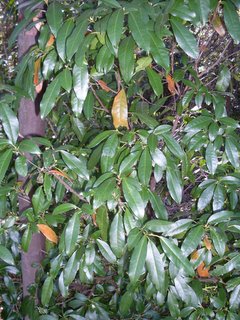Green native cascarilla facts for kids
Quick facts for kids Green native cascarilla |
|
|---|---|
 |
|
| Green native cascarilla at Eastwood, Australia | |
| Scientific classification | |
| Genus: |
Croton
|
| Species: |
verreauxii
|
The Green native cascarilla (scientific name: Croton verreauxii) is a small tree or shrub. It grows in dry rainforests and along the edges of rainforests in eastern Australia.
You can find this plant naturally from Kiama in eastern New South Wales up to Gympie in south-eastern Queensland. It has also been seen as far north as Darwin, Northern Territory.
What Does It Look Like?
The Green native cascarilla is usually a shrub. It often grows where eucalyptus forests meet rainforests. But it can also grow inside rainforests. There, it can become a tree up to 20 metres (about 65 feet) tall. Its trunk can be 20 centimetres (about 8 inches) wide.
Trunk and Branches
The tree has a short, often bent trunk. It does not have large, wide supports at its base. Branches usually grow close to the ground. The bark is dark brown and sometimes has thin cracks running up and down. Younger branches are grey and thin. They might have small bumps or hairs. If you crush a small branch, you might notice a pleasant, sweet smell.
Leaves
The leaves grow one after another along the stem. They are usually blunt at the tip and can be rounded or narrow at the base. The top of the leaf is shiny green. The underside is a bit duller. You might see an occasional orange leaf in the tree's top branches. This means the leaf is getting old.
Leaves are usually 5 to 12 centimetres (2 to 5 inches) long. They are oval-shaped. Their edges can be smooth or have small teeth. The leaf stalks are 5 to 13 millimetres (about 0.2 to 0.5 inches) long. They have a groove on their upper side. At the very top of each leaf stalk, there are two tiny glands.

Flowers and Fruit
Yellowish-green flowers grow in clusters called racemes. They appear between November and January. Each plant has both male and female flowers.
The fruit is an orange-brown capsule. It has three parts, or lobes. Each lobe holds one reddish-brown seed. The seeds are smooth and have angles. They are about 2 millimetres (0.08 inches) across. The fruit usually ripens from April to September. However, you might find ripe fruit at other times of the year too.
See also
 In Spanish: Cascarilla verde australiana para niños
In Spanish: Cascarilla verde australiana para niños

